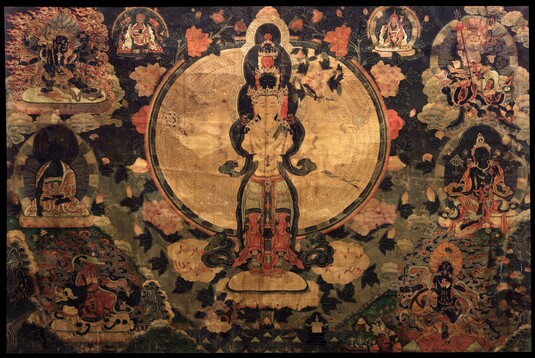
Item: Avalokiteshvara (Bodhisattva & Buddhist Deity) - Sahasrabhujalokeshvara (11 faces, 1000 Hands)
| Origin Location | China |
|---|---|
| Date Range | 1800 - 1899 |
| Lineages | Nyingma and Gelug |
| Material | Ground Mineral Pigment on Cotton |
| Collection | Lostand Foundation |
Alternate Names: Lokeshvara Avalokita Lokanata Lokanatha Mahakarunika
Classification: Deity
Appearance: Peaceful
Gender: Male
Avalokiteshvara, Ekadasamukha (Tibetan: chen re zig, shal chu jig. English: the Eleven Faced Lord Gazing on the World): the bodhisattva of compassion with 1000 hands (Sanskrit: sahasrabhuja).
Peaceful in appearance, with eleven faces rising upward in groups of three, the 10th is wrathful and the face at the top is that of the buddha Amitabha. Each face has two eyes and long black hair flows across the shoulders. With 5000 pairs of hands, the first 8 are distinct. The first pair at the heart holds a single precious jewel. The three right hands extended to the side are in the mudra of generosity, holding a Dharma wheel and a crystal prayer bead mala. The three on the left hold a water flask, a bow and arrow and a lotus blossom. Each face is adorned with a gold crown, ribbons and earrings. Necklaces, bracelets and precious jewels adorn the body and a scarf is wrapped about the neck. A deerskin is worn across the left shoulder and the lower body is covered in various silk fabrics. With the two legs together he stands atop a lotus flower surrounded by radiant light forming a thin green and orange nimbus around the body and smaller green areolas about the heads.
At the upper right is Guru Rinpoche Padamsambhava with another lama sitting on the left hand side. At the left corner is Vajrakila. Below that is Buddha Akshobhya and below that the worldly protector Vajra Sadhu. At the right corner is White Jambhala riding a dragon. Below that is Green Tara and below that is a two armed form of Shri Devi (Tib.: pel den lha mo) holding a sword and skullcup.
The bodhisattva Avalokiteshvara is the patron deity of Tibet and appears in a variety of forms both peaceful, wrathful and in large mandalas surrounded by numerous deities. As a universal symbol he embodies the compassion of all buddhas of the ten directions and three times. In the standing form with 11 faces he is closely associated with the famous bhikshuni (nun) of Kashmir, Lakshmi (Tib.: Ani Palmo), who popularized a meditation practice incorporating a 2 day purification and fasting ritual. Lord Atisha, Rinchen Zangpo and others popularized this practice throughout Tibet.
History: At one time the bodhisattva Avalokiteshvara made a promise that should he give rise to thoughts of self benefit may the head break into 10 pieces and the body into 1000. After continuously witnessing the misery of beings in various states of existence, discouraged, he gave rise to thoughts of seeking only his own happiness. At that very instant the head and body shattered. Calling out to Amitabha, the buddha came forth and spoke words of encouragement. Gathering up the 10 pieces of the head Amitabha constructed 10 faces - representing the 10 perfections. Gathering the 1000 pieces of the body he constructed another with 1000 hands each with an eye on the palm - representing the 1000 buddhas of the Golden Aeon. Finally he placed a duplicate of his own head at the crown - illuminating the entire threefold universe.
Jeff Watt 4-2000
Collection of Lostand Foundation
Tradition: Nyingma Deity Paintings
Buddhist Deity: Avalokiteshvara Main Page
Buddhist Deity: Avalokiteshvara (Eleven Faces)
Painting Type: Landscape Format (Deities & Figures)

